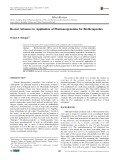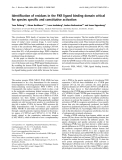
Of drug metabolism
-
Biotherapeutics (BTs), one of the fastest growing classes of drug molecules, offer several advantages over the traditional small molecule pharmaceuticals because of their relatively high specificity, low off-target effects, and biocompatible metabolism, in addition to legal and logistic advantages. However, their clinical utility is limited, among other things, by their high immunogenic potential and/or variable therapeutic efficacy in different patient populations.
 7p
7p  caothientrangnguyen
caothientrangnguyen
 09-05-2020
09-05-2020
 23
23
 1
1
 Download
Download
-
Quantifying the multiple processes which control and modulate the extent of oral bioavailability for drug candidates is critical to accurate projection of human pharmacokinetics (PK). Understanding how gut wall metabolism and hepatic elimination factor into first-pass clearance of drugs has improved enormously. Typically, the cytochrome P450s, uridine 5′- diphosphate-glucuronosyltransferases and sulfotransferases, are the main enzyme classes responsible for drug metabolism. Knowledge of the isoforms functionally expressed within organs of first-pass clearance, their anatomical topology (e.
 16p
16p  caothientrangnguyen
caothientrangnguyen
 09-05-2020
09-05-2020
 19
19
 1
1
 Download
Download
-
The cytochrome P450 family of enzymes has long been known tometabolize a wide range of compounds, including many of today’s most common drugs. A novel nuclear receptor called PXR has been established as an activator of several of the cytochrome P450 genes, including CYP3A4. This enzyme is believed to account for the metabolism of more than 50% of all prescription drugs. PXR is therefore used as a negative selector target and discriminatory filter in preclinical drug development.
 9p
9p  research12
research12
 29-04-2013
29-04-2013
 44
44
 3
3
 Download
Download
-
Liver microsomal preparations are routinely used to predict drug interactions that can occurin vivo as a result of inhi-bition of cytochrome P450 (CYP)-mediated metabolism. However, the concentration of free drug (substrate and inhibitor)at its intrahepatic site of action, a variable that cannot be directly measured, may be significantly different from that in microsomal incubation systems.
 10p
10p  tumor12
tumor12
 20-04-2013
20-04-2013
 47
47
 4
4
 Download
Download
-
Malaria remains a major health problem especially in trop-ical and subtropical regions of the world, and therefore developing new antimalarial drugs constitutes an urgent challenge. Lipid metabolism has been attracting a lot of attention as an application for malarial chemotherapeutic purposes in recent years. However, little is known about glycosphingolipid biosynthesis inPlasmodium falciparum. In this report we describe for the first time the presence of an active glucosylceramide synthase in the intraerythrocytic stages of the parasite....
 11p
11p  dell39
dell39
 03-04-2013
03-04-2013
 31
31
 4
4
 Download
Download
-
Prolonged exposure of pancreatic beta cells to the sulfonylureas glibenca-mide and tolbutamide induces subsequent desensitization to the actions of these drugs. The precise mechanisms underlying this desensitization remain unknown, prompting the present study, which investigated the impact of prolonged sulfonylurea exposure on glucose and energy metabolism using clonal pancreatic BRIN-BD11 beta cells.
 9p
9p  inspiron33
inspiron33
 23-03-2013
23-03-2013
 42
42
 4
4
 Download
Download
-
In the search for new drug targets in the human parasite Entamoeba histolytica, metabolic control analysis was applied to determine, experimen-tally, flux control distribution of amebal glycolysis. The first (hexokinase, hexose-6-phosphate isomerase, pyrophosphate-dependent phosphofructo-
 16p
16p  galaxyss3
galaxyss3
 07-03-2013
07-03-2013
 52
52
 4
4
 Download
Download
-
Branched-chain lipids are important components of the human diet and are used as drug molecules, e.g. ibuprofen. Owing to the presence of methyl groups on their carbon chains, they cannot be metabolized in mitochon-dria, and instead are processed and degraded in peroxisomes. Several dif-ferent oxidative degradation pathways for these lipids are known, including a-oxidation, b-oxidation, and x-oxidation.
 14p
14p  media19
media19
 06-03-2013
06-03-2013
 39
39
 3
3
 Download
Download
-
Constitutively expressed human cytochrome P450 2D6 (CYP2D6; EC 1.14.14.1) is responsible for the metabolism of approximately 25% of drugs in common clinical use. It is widely accepted that CYP2D6 is localized in the endoplasmic reticulum of cells; however, we have identified this enzyme in the mitochondria of human liver samples and found that extensive inter-individual variability exists with respect to the level of the mitochondrial enzyme.
 14p
14p  viettel02
viettel02
 22-02-2013
22-02-2013
 44
44
 4
4
 Download
Download
-
The present study aimed to determine the role of Kupffer cells (KCs) in cytochrome P450 (CYP) isozyme activity and the expression of its gene during polymicrobial sepsis. For ablation of KCs, rats were pretreated with gadolinium chloride (GdCl3 ) at 48 and 24 h before cecal ligation and punc-ture (CLP). The depletion of KCs was confirmed by measuring the mRNA level of the KC marker gene CD163.
 11p
11p  cosis54
cosis54
 05-01-2013
05-01-2013
 42
42
 4
4
 Download
Download
-
Tuyển tập các báo cáo nghiên cứu về y học được đăng trên tạp chí y học Critical Care giúp cho các bạn có thêm kiến thức về ngành y học đề tài: Drug metabolizing enzyme activities versus genetic variances for drug of clinical pharmacogenomic relevance...
 9p
9p  thulanh17
thulanh17
 27-10-2011
27-10-2011
 38
38
 2
2
 Download
Download
-
Thyroiditis is the inflammation of the thyroid gland. The thyroid gland is located on the front of the neck below the laryngeal prominence, and makes hormones that control metabolism. There are many different types of thyroiditis, with the most common being Hashimoto's thyroiditis. Other forms of the disease are postpartum thyroiditis, subacute thyroiditis, silent thyroiditis, drug-induced thyroiditis, radiation-induced Association, 2008).
 4p
4p  truongthiuyen2
truongthiuyen2
 10-06-2011
10-06-2011
 91
91
 3
3
 Download
Download
CHỦ ĐỀ BẠN MUỐN TÌM
























